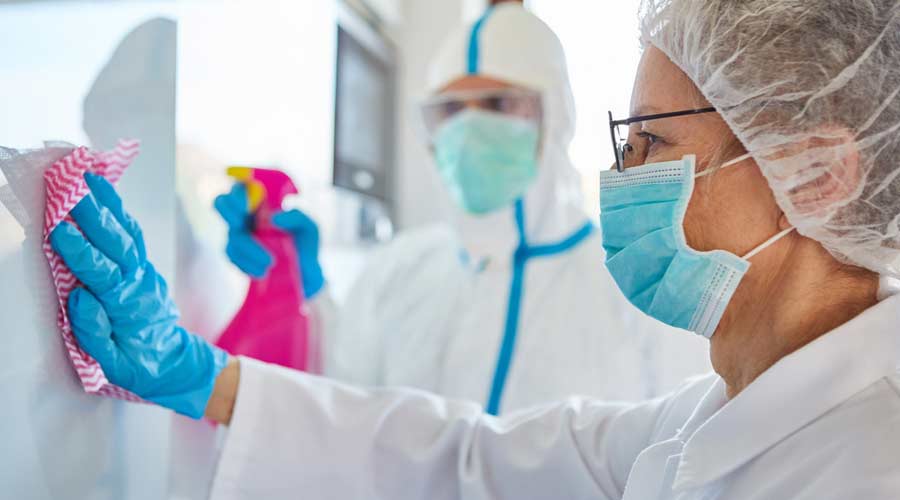As much as people would like to live in a completely sterile environment, it is not possible or particularly helpful. A certain number of bacteria is healthy because it helps build immunity. But there are some germs that no one wants to find in a healthcare facility — the kind that make us ill, including salmonella, E. coli, staphylococcus and mold.
Many people have heard restroom hand dryers help spread fecal bacteria on people’s hands, but did they know there is fecal bacteria everywhere? That’s right. While people have been freaking out over headlines suggesting a tiny amount of fecal bacteria is lurking on hands or faucets, those studies have been amassing into a whole body of research that shows pretty definitively that fecal bacteria is everywhere.
"We're all walking around, breathing, and covered in a fine veneer of poo, and yet we’re all (probably!) going to be fine,” says Phillip M. Tierno, a microbiologist at New York University and the author of The Secret Life of Germs Observations and Lessons from a Microbe Hunter. “You don’t get sick from feces, per se. It’s only an indicator that there may be pathogenic organisms found. It’s disingenuous for people to equate feces with getting ill.” People can get sick from touching or ingesting fecal matter if it contains something like salmonella or shigella. If that’s the case, even a little bit is enough to get you sick, says Kelly Reynolds, a University of Arizona microbiologist.
“Many fecally transmitted microbes can cause disease at very low levels (1–10 organisms),” Reynolds says. “Since they are typically shed at very high numbers (tens of billions per gram of feces), even small amounts are enough to make people sick.”
A February 2022 study found that 90 percent of 337 high-touch surfaces from 11 long-term care facilities tested positive CrAssphage, a DNA bacteriophage that indicates past or present fecal contamination, or they had organic levels that resulted in failing cleanliness scores. CrAssphage is a recently discovered human gut-associated bacteriophage. CrAssphage sequences could be grouped into two major genetic clusters. Our data suggest that CrAssphage could be used to detect human fecal contamination on environmental surfaces and hands.
Diarrheal illnesses caused by norovirus and C. difficile infections (CDI) are among the most frequent healthcare-associated infections in long-term care facilities. In the United States, approximately 60 percent of norovirus outbreaks and more than 50 percent of all healthcare-associated CDI occur in long-term care facilities.
Both pathogens can be transmitted by environmental surfaces contaminated with fecal matter. While environmental monitoring using surface-hygiene indicators is a valuable tool to help prevent the spread of infection, there are no standard technologies or methodologies, and many monitoring tools are too expensive to be used routinely. Although the published study was confined to long-term care facilities, hospital and acute rehabilitation facilities need to monitor their cleaning practices and refine their infection-prevention plans to better protect patients from serious diarrheal illnesses.
J. Darrel Hicks, BA, MESRE, CHESP, Certificate of Mastery in Infection Prevention, is the past president of the Healthcare Surfaces Institute. Hicks is nationally recognized as a subject matter expert in infection prevention and control as it relates to cleaning. He is the owner and principal of Safe, Clean and Disinfected. His enterprise specializes in B2B consulting, webinar presentations, seminars and facility consulting services related to cleaning and disinfection. He can be reached at darrel@darrelhicks.com, or learn more at www.darrelhicks.com.

 UF Health Hospitals Rely on Green Globes to Realize Their Full Potential
UF Health Hospitals Rely on Green Globes to Realize Their Full Potential How Healthcare Facilities Can Be Truly Disaster-Resilient
How Healthcare Facilities Can Be Truly Disaster-Resilient TriasMD Breaks Ground on DISC Surgery Center for San Fernando Valley
TriasMD Breaks Ground on DISC Surgery Center for San Fernando Valley Bigfork Valley Hospital Falls Victim to Data Breach
Bigfork Valley Hospital Falls Victim to Data Breach AI-Driven Facilities: Strategic Planning and Cost Management
AI-Driven Facilities: Strategic Planning and Cost Management